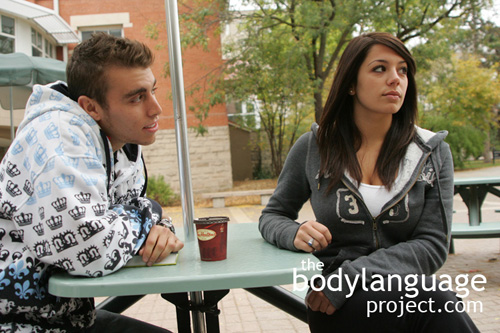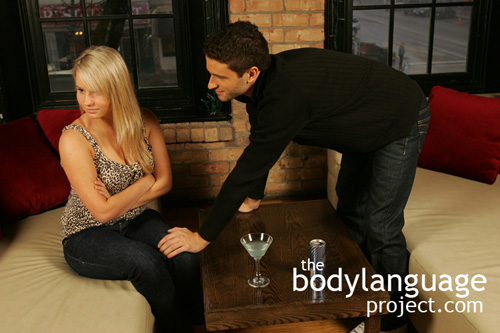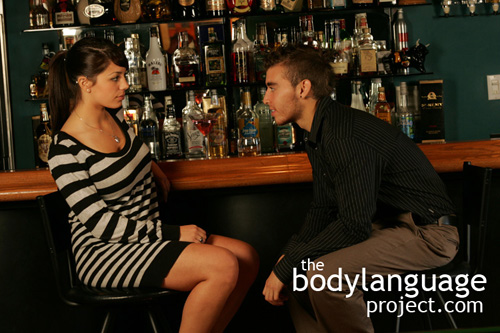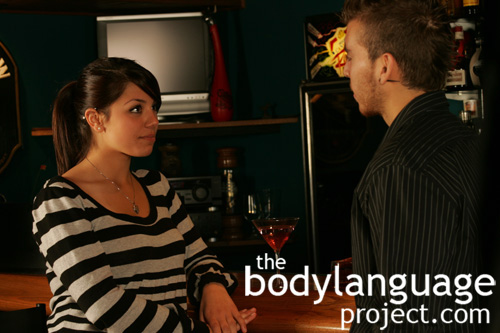Body Language of Leaning In and Leaning Out



 Cue: Leaning In and Leaning Out.
Cue: Leaning In and Leaning Out.
Synonym(s): Pecking Forward, Leaning Out.
Description: Leaning forward or away from another person (or thing).
In One Sentence: Leaning in and leaning out signal interest and disinterest respectively.
How To Use it: Use leaning in and leaning out to show your level of interest. Leaning in shows people that you are interested in them, their ideas and/or what they have to say. Leaning out sends the reverse message.
Leaning language is applicable in business, dating and amongst friends.
For example, leaning in toward your dating partner shows him or her that you wish to gain intimacy. In a business meeting or presentation sit at the edge of your seat and lean in toward the presenter to show them you are keen on the information. With friends at lunch, sit facing them and engage them with conversation by moving forward. These postures all work in reverse to show disinterest. Additionally, leaning in and out can be done while standing and send a similar message. Leaning in also shows a readiness for action. This is also a positive message – especially in business and dating.
Context: a) Dating, b) General.
Verbal Translation: “I’m interested in what you are saying and am supplicating to your dominance and ability to draw me in closer to you, rather than you, to me. That’s why I’m leaning forward.”
Variant: See Head Away.
Cue In Action: a) Dave was really into Stacey. Throughout lunch, he tried to engage her as much as possible but found the more he leaned in, the more she leaned out and away. It was clear that he was more into her, than vice versa. b) While presenting to the crowd, she found half of the students leaning in and engaged, while the other half leaned out and away. She knew which students where most keen on the topic from the way their bodies leaned.
Meaning and/or Motivation: Leaning in too much, also referred to as “pecking” forward has been advanced by the pick-up community as a term describing men who appear needy and who lack control of the dating situation rather than dominant and chase-worthy.
Pecking forward can appear in any setting and shows which of the two are most interested in the other or whom is most dominant and in control. Or, sometimes more aptly, leaning away tells us which person is more apathetic to the relationship and apathy often creates control and ability to dominate. Dominant people will tend to lean back and take up space, but someone who lacks confidence or whom has a great interest in another person will try to engage them more by leaning in toward them. This tends to have the reverse result to what is intended.
Leaning back will force others to engage you, instead of the other way around (cat and mouse game.) Talking quietly also has the affect of forcing people to move closer to you, thereby increasing your status.
Cue Cluster: Couple leaning in and leaning out with other nonverbal cues to determine level of engagement. Leaning in should find itself with eye contact, nodding, smiling, smooth flowing conversation and head tilted to the side – this shows engagement. Leaning back, and disengagement should find itself with lack of eye contact, lack of nodding, deadpan face, stuttered conversation and head-on rather than head tilted.
Body Language Category:
Leaning In: Amplifier, Attentive, Body pointing, Indicator of interest (IoI),
Indicators of sexual interest (IOsI), Intention movements, Low confidence body language, Liking.
Leaning Away: Amplifier, Body pointing, Confident body language, Disengagement, Dislike (nonverbal), Distancing or moving away, Dominant body language Escape movements, Expansive movements, Indicators of disinterest (IOD), Indicators of sexual disinterest (IOsD), Intention movements, Power play.
Resources:
Astrom, Jan. Introductory greeting behavior: a laboratory investigation of approaching and closing salutation phases. Perceptual and Motor Skills. 1994. 79(2): 863(35).
Argyle, M., & Dean, I. Eye contact, distance and affiliation. Sociometry, 1965, 28, 289-304.
Baxter, James C. ; Rozelle, Richard M. Lanzetta, John T. (editor). Nonverbal expression as a function of crowding during a simulated police-citizen encounter. Journal of Personality and Social Psychology. 1975. 32(1): 40-54.
Boucher, Michael L. Holzberg, Jules D. (editor). Effect of seating distance on interpersonal attraction in an interview situation. Journal of Consulting and Clinical Psychology. 1972 38(1): 15-19.
Cook, M. Experiments on orientation and proxemics. Human Relations, 1970, 23, 61-67.
Clack, B., Dixon, J., & Tredoux, C. (2005). Eating together apart: Patterns of segregation in a multi-ethnic cafeteria. Journal of Community & Applied Social Psychology, 15, 1-16. doi:10.1002/casp.787
Cashdan, Elizabeth. Smiles, Speech, and Body Posture: How Women and Men Display Sociometric Status and Power. Journal of Nonverbal Behavior. 1998. 22(4): 209-228.
Chance RMA (1962) An interpretation of some agonistic postures: the role of “cut-off” acts and postures. Symp Zool Soc Lond 8: 71–89.
Chaikin, Alan L. ; Gillen, Barry ; Derlega, Valerian J. ; Heinen, James R. K. ; Wilson, Midge. Students’ reactions to teachers’ physical attractiveness and nonverbal behavior: Two exploratory studies. Psychology in the Schools. 1978. 15(4): 588-595.
DeSteno, D.; Breazeal, C.; Frank, R. H.; Pizarro, D.; Baumann, J.; Dickens, L, and Lee, J. Detecting the Trustworthiness of Novel Partners in Economic Exchange. Psychological Science. 2012. 23, 1549-1556.
http://bodylanguageproject.com/articles/use-body-language-cues-create-trust
Doody, John ; Bull, Peter. Asperger’s Syndrome and the Decoding of Boredom, Interest, and Disagreement from Body Posture. Journal of Nonverbal Behavior. 2011. 35(2): 87-100.
Dowell, Nia M. and Jeffrey S. Berman. Therapist Nonverbal Behavior and Perceptions of Empathy, Alliance, and Treatment Credibility. Journal of Psychotherapy Integration. 2013. 23(2): 158-165. DOI: 10.1037/a0031421. http://bodylanguageproject.com/articles/lean-make-eye-contact-create-impressions-empathy-leaning-body-language-creates-greater-credibility
Felipe, N. Interpersonal distance and small group interaction. Cornell Journal of Social Relations, 1966, 1, 59-64.
Fretz, Bruce R. Counselor Nonverbal Behaviors and Client Evaluations. Journal of Counseling Psychology. 1979. 26(4): 304-11.
Genthner, Robert W. ; Moughan, James Osipow, Samuel H. (editor). Introverts’ and extraverts’ responses to nonverbal attending behavior. Journal of Counseling Psychology. 1977. 24(2): 144-146.
Girard, Jeffrey M.; Jeffrey F. Cohna; Mohammad H.Mahoor S.; Mohammad Mavadati;
Zakia Hammal; and Dean P. Rosenwalda. Nonverbal Social Withdrawal In Depression: Evidence From Manual And Automatic Analyses. Image and Vision Computing. 2013.
http://bodylanguageproject.com/articles/body-language-signals-withdrawal-depression/
Gorkan Ahmetoglu, Viren Swami. Do Women Prefer “Nice Guys?” The Effect Of Male Dominance Behavior On Women’s Ratings. Social Behavior And Personality, 2012; 40(4), 667-672.
http://bodylanguageproject.com/articles/how-to-significantly-increase-male-attractiveness-with-simple-body-language-nice-guys-finish-last-once-again/
Gregersen, Tammy S. Nonverbal Cues: Clues to the Detection of Foreign Language Anxiety. Foreign Language Annals. 2005. 38(3): 388-400
http://bodylanguageproject.com/articles/what-anxious-learners-can-tell-us-about-anxious-body-language-how-to-read-nonverbal-behavior/
Goodboy, Alan, K. and Maria Brann. Flirtation Rejection Strategies: Towards an Understanding of Communicative Disinterest in Flirting. The Quantitative Report. 2010. 15(2): 268-278.
http://bodylanguageproject.com/articles/how-to-reject-flirting-using-nonverbal-and-verbal-tactics/
Gifford, Robert ; O’Connor, Brian. Nonverbal intimacy: Clarifying the role of seating distance and orientation. Journal of Nonverbal Behavior. 1986 10(4): 207-214.
Gardin, Hershel ; Kaplan, Kalman J. ; Firestone, Ira J. ; Cowan, Gloria A. Lanzetta, John T. (editor). Proxemic effects on cooperation, attitude, and approach-avoidance in a Prisoner’s Dilemma game. Journal of Personality and Social Psychology. 1973. 27(1): 13-18.
Haase, Richard F. ; Dimattia, Dominic J. Berdie, Ralph F. (editor). Proxemic behavior: Counselor, administrator, and client preference for seating arrangement in dyadic interaction. Journal of Counseling Psychology. 1970 17(4): 319-325.
Hall, Jeffrey A. and Chong Xing. The Verbal and Nonverbal Correlates of the Five Flirting Styles. Journal of Nonverbal Behavior. 2015. 39:41–68. DOI 10.1007/s10919-014-0199-8
http://bodylanguageproject.com/articles/first-12-minutes-flirting-using-nonverbal-communication-study-reveals-26-body-language-cues-attraction/
Harrigan J. and Rosenthal R. Physicians’ head and body positions as determinants of perceived rapport. J. appl. Sot. Psychol. 13, 496, 1983.
Hall, Judith ; LeBeau, Lavonia ; Reinoso, Jeannette ; Thayer, Frank. Status, Gender, and Nonverbal Behavior in Candid and Posed Photographs: A Study of Conversations Between University Employees. Sex Roles. 2001 44(11): 677-692.
Hietanen, Jari. Social attention orienting integrates visual information from head and body orientation. Psychological Research.2002 66(3): 174-179.
Jenkins, R., Beaver, J.D., & Calder, A.J. (2006). I thought you were looking at me: Direction-specific aftereffects in gaze perception. Psychological Science, 17, 506–513.
Katza, Carmit; Irit Hershkowitz; Lindsay C. Malloya; Michael E. Lamba; Armita Atabakia and Sabine Spindlera. Non-Verbal Behavior of Children Who Disclose or do not Disclose Child Abuse in Investigative Interviews. Child Abuse & Neglect. 2012. 36: 12-20.
http://bodylanguageproject.com/articles/reading-nonverbal-behaviour-child-abuse-cases-encourage-children-divulge-information-truth-telling
Kahlbaugh, Patricia ; Haviland, Jeannette. Nonverbal communication between parents and adolescents: A study of approach and avoidance behaviors. Journal of Nonverbal Behavior. 1994 18(1): 91-113.
Langton, S. R. H., & Bruce, V. (2000). You must see the point: Automatic processing of cues to the direction of social attention. Journal of Experimental Psychology: Human Perception and Performance, 26, 747–757.
Langton, S. R. H. (2000). The mutual influence of gaze and head orientation in the analysis of social attention direction. The Quarterly Journal of Experimental Psychology, 53A, 825–845.
Mehrabian, Albert Holzberg, Jules D. (editor). Inference of Attitudes From the Posture, Orientation and Distance of a Communicator. Journal of Consulting and Clinical Psychology. 1968. 32(3): 296-308.
Mehrabian, Albert Deese, James (editor). Significance of posture and position in the communication of attitude and status relationships. Psychological Bulletin. 1969. 71(5): 359-372.
Mehrabian, Albert (1969). “Significance of Posture and Position in the Communication of Attitude and Status Relationships.” In Psychological Bulletin (Vol. 71), pp. 359-72.
Mehrabian, Albert (1974). “Communication Without Words.” In Jean Civikly, ed., Messages: A Reader in Human Communication (New York: Random House), pp. 87-93.
Moore, Monica. Courtship Signaling and Adolescents: Girls Just Wanna Have Fun. Journal of Sex Research. 1995. 32(4): 319-328.
http://bodylanguageproject.com/articles/girls-just-want-to-have-fun-the-origins-of-courtship-cues-in-girls-and-women/
Remland, Martins. ; Jones, Tricias. ; Brinkman, Heidi. Interpersonal Distance, Body Orientation, and Touch: Effects of Culture, Gender, and Age. The Journal of Social Psychology. 1995 135(3): 281-297.
Roberts, Lisa ; Bucksey, Sally J. Communicating with patients: what happens in practice? Physical therapy. 2007. 87(5): 586-94.
St J. Neill, S.R. The Effects of Facial Expression and Posture on Children’s Reported Responses to Teacher Nonverbal Communication. British Educational Research Journal. 1989. 15(2): 195-204.
Sommer, R. Studies in personal space. Sociometry, 1959, 22,247-260.
Sommer, R. The distance for comfortable conversation: A further study. Sociometry, 1962, 25, 111-116.
Sommer, R. Personal space: The behavioral basis of design. Englewood Cliffs, New Jersey: Prentice Hall. 1969.
Trout, Deborah ; Rosenfeld, Howard. The effect of postural lean and body congruence on the judgment of psychotherapeutic rapport. Journal of Nonverbal Behavior. 1980. 4(3): 176-190.
Underwood, M. K.. Glares of Contempt, Eye Rolls of Disgust and Turning Away to Exclude: Non-Verbal Forms of Social Aggression among Girls. Feminism & Psychology. 2004 14(3): 371-375
Zeinstra, Gertrude G.; M.A. Koelen; D. Colindres ; F.J. Kok; C de Graaf. Facial Expressions in School-Aged Children are a Good Indicator of ‘Dislikes’, but not of ‘Likes.’ Food Quality and Preference. 2009. 20: 620-624.
http://bodylanguageproject.com/articles/read-kids-dislike-food-facial-expressions-accurate-detecting-dislike-not-like-children/







